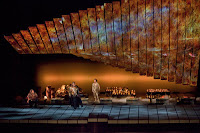As a frequent Metropolitan Opera goer, I haven't gotten out to see many Broadway shows in recent years. So I was delighted to catch up with the performance of
Wicked during its latest Columbus run. While not the same caliber experience as the opening cast on Broadway, the touring company versions we get here compare well to the later casts of long-running shows in NYC.
Wicked was no exception: bright, energetic, entertaining, with an appreciative audience; it made for a very enjoyable evening.
Wicked is currently the longest-running show on Broadway (it opened in Oct. 2003). I wanted to see it mainly to learn the backstory it presented to
The Wizard of Oz. For those who haven't seen it,
Wicked tells the Oz story from the perspective of the Wicked Witch of the West. We learn how the Cowardly Lion, Tin Man, and Scarecrow came to be as well as many other aspects of the story that, thanks to Judy Garland, is so well known to all of us.
While I was being entertained by the show, songs, and story, I kept thinking how we grow up thinking of history in one way. Of course,
The Wizard of Oz is fiction, not real history. But
Wicked asks us think whether the story we know so well is what really happened.
So while I was watching and listening, I thought about Josephine Tey's book
The Daughter of Time and learning at Cornell several years ago what the study of history is all about. (See my prior blog:
Why Study History?) In her book, Tey turns around the story of King Richard III and asks the reader to question whether history's view of the wicked hunchbacked Richard portrayed by Shakespere in his play (and by Lawrence Olivier on the screen), is really accurate. History, after all, is written by the victors, and in Richard III's case, depicting Richard as wicked served the purposes of the succeeding Tudor dynasty. Tey raises her question, though, through a fictional mystery story, much as Dan Brown raised his question, 52 years later, on Jesus Christ's real relationship with Mary Magdalene in his wildly popular
The Da Vinci Code.
A more direct history vs. history challenge has been raised by Gavin Menzies in his book
1421: The Year China Discovered the World in which Menzies challenges the story American schoolchildren have learned for generations: that the European explorers starting with Christopher Columbus discovered the sea routes that led to the Americas, Africa, and Asia. The romantic history we were taught is that Columbus and other Europeans were so bold that they questioned the flat earth notions of the time. Menzies reveals documentary and other evidence that Chinese Admiral Zheng He led Ming Dynasty treasure ships around the world in and after the year 1421 and prepared maps that reflected the world - maps that ultimately Columbus and the other European explorers had seen that helped them in their voyages.
American education has long been criticized as being far too Euro-centric. My purpose in this blog entry isn't to carry on that debate (I'll leave that issue to a future blog), but to raise the issue of questioning what we know.
Questioning what we know can be a dangerous pursuit. Neil deGrasse Tyson, director of the Hayden Planetarium at the American Museum of Natural History, wrote of the slings and arrows he suffered in questioning what we all think we know in his book and PBS show
The Pluto Files. When Tyson and other astronomers downgraded Pluto's status from "planet" to "Kuiper Belt Object" he and his colleagues were
vilified by the venerable NY Times and scores of third-graders (at least until the
Times published another story, 5 years later, acknowledging the reasonable position the scientists had taken). So many of us learned (and had drilled into us) the fact that there are 9 planets in our solar system; that history must be respected and protected. As one who once aspired to be an astronomer myself, my sympathies are with Tyson. But the reasons for my sympathies go further.
One of the fundamental purposes of post-secondary education is to develop critical thinking. But thinking critically about issues - whether they be about stories, histories, or the definition of scientific terms such as "planet" - is not merely an intellectual ability. Critical thinking is also a disposition: a willingness to undertake the hard work of questioning what we are being presented with. Such disposition does not come naturally after 12 or so years of elementary and secondary school education in the U.S., since much of what we learn in school is so often presented as unquestioned fact to be accepted and memorized.
With the continually growing volume of factionalized political argument we are faced with, the future of our democratic system of government and the future of our country depend on our ability to instill more Americans with the ability and disposition to think critically about the "facts" we are presented with and the choices we are being asked to make. I am delighted that a Broadway show might get some in the audience to question what they know and so help underscore the importance of critical thinking.




















































